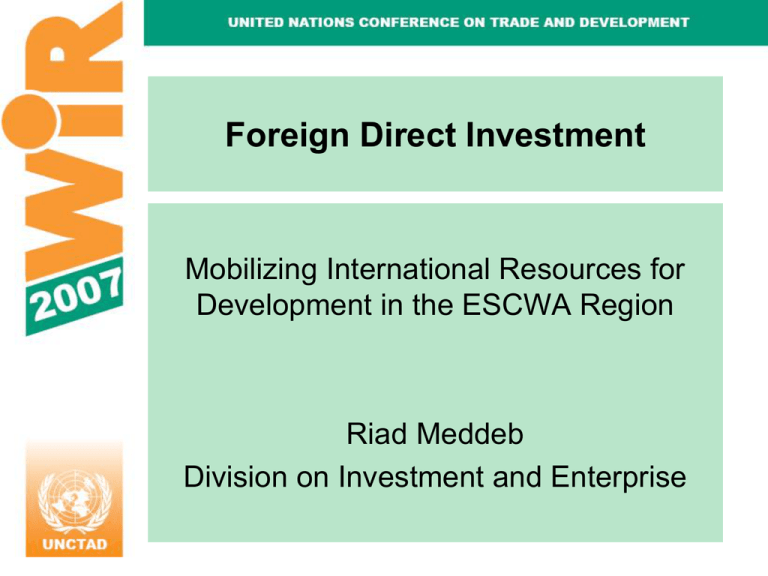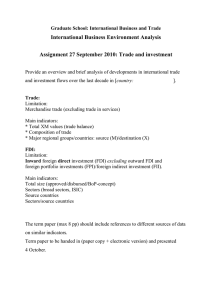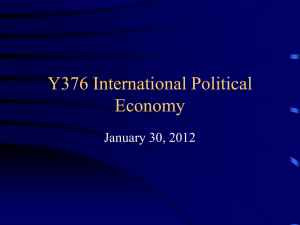Mobilizing International Resources for
advertisement

Foreign Direct Investment Mobilizing International Resources for Development in the ESCWA Region Riad Meddeb Division on Investment and Enterprise I- FDI trends in ESCWA region II- FDI and development : Challenges for ESCWA countries I FDI TRENDS IN ESCWA REGION ESCWA in Comparison 14 12 10 8 6 4 2 0 2002 2003 2004 2005 ESCWA: rate of return Developing economies: rate of return World: rate of return Inflow: share in developing countries Exports of goods and services: share in developing countries GDP: share in developing countries 2006 FDI Inflows 400'000 Millions of US Dollars 350'000 300'000 250'000 200'000 150'000 100'000 50'000 0 2002 2003 ESCWA Total 2004 2005 Developing Economies Source: UNCTAD, FDI/TNC database (www.unctad.org/fdistatistics/) 2006 Top Recipient Countries Top 6 by FDI Inflows, 2006 Lebanon Bahrain Jordan United Arab Emirates 2006 Egypt Saudi Arabia 0 5'000 10'000 Millions of USD Source: UNCTAD, FDI/TNC database (www.unctad.org/fdistatistics/) 15'000 20'000 FDI Inflows by Country FDI Inflows (in millions of US Dollars) 2002 2003 2004 2005 2006 Saudi Arabia 453 778 1'942 12'097 18'293 Egypt 647 237 2'157 5'376 10'043 1'307 4'256 10'004 10'900 8'386 Jordan 74 436 651 1'532 3'121 Bahrain 217 517 865 1'049 2'915 1'336 2'977 1'993 2'751 2'794 Qatar 624 625 1'199 1'152 1'786 Oman 122 494 229 900 952 Syrian Arab Republic 115 180 275 500 600 -2 0 300 515 272 Kuwait 4 -67 24 250 110 Palestinian Territory 9 18 49 47 38 102 6 144 -302 -385 5'008 10'457 19'831 36'767 48'924 United Arab Emirates Lebanon Iraq Yemen Total Source: UNCTAD, FDI/TNC database (www.unctad.org/fdistatistics/) Distribution of FDI flows among ESCWA countries, by range, 2006 Range Inflows Outflows Over $5 billion Saudi Arabia, UAE, Egypt Kuwait $3-4.9 billion Jordan $1-2.9 billion Bahrain, Lebanon, Qatar UAE $0.5-0.9 billion Oman, Syrian Arab Republic Bahrain Saudi Arabia $0.1-0.4 billion Iraq, Kuwait Qatar, Oman Less than $0.1 billion Palestinian territory , Yemen Lebanon, Syrian Arab Rep, Yemen, Paletianian territory and Jordan Source:TNC database (www.unctad.org/fdistatistics/) FDI Outflows 200'000 180'000 Millions of US Dollars 160'000 140'000 120'000 100'000 80'000 60'000 40'000 20'000 0 -20'000 2002 2003 ESCWA Total 2004 2005 Developing Economies Source: UNCTAD, FDI/TNC database (www.unctad.org/fdistatistics/) 2006 FDI Outflows Top 6 by FDI Outflows, 2006 Oman Qatar Saudi Arabia Bahrain United Arab Emirates Kuwait 0 1000 2000 3000 4000 5000 Millions of USD Source: UNCTAD, World Investment Report 2007. 6000 7000 8000 9000 FDI Outflows by Country FDI Outflows (millions of US Dollars) 2002 2003 2004 2005 2006 Kuwait -77 -4'960 2'526 5'142 7'892 United Arab Emirates 413 991 2'208 3'750 2'316 Bahrain 190 741 1'036 1'123 980 Saudi Arabia 211 368 709 1'183 753 Qatar -21 88 192 352 379 Oman 3 153 250 114 247 Egypt 28 21 159 92 148 0 40 213 122 71 119 57 48 61 55 39 61 21 26 36 2'907 -437 9'366 13'970 14'883 Lebanon Syrian Arab Republic Yemen Total Source: UNCTAD, FDI/TNC database (www.unctad.org/fdistatistics/) Top Recipient Sectors • Services remained the dominant sector for FDI in the region, a major proportion of which went to financial services. • There were also several large deals in telecommunications. • High oil prices have are attracting increasing FDI in oil and gas-related industries. • GCC countries with large surpluses are rapidly increasing expenditures on large infrastructure projects, which are also attracting more FDI. Diversifying Industries • The Gulf countries seeking to diversify their production activities beyond oil-related activities have set up initiatives to attract FDI into the manufacturing sector. • One example is the establishment of Free Trade and Industrial Zones in the United Arab Emirates. • The largest of these zones is the Jebel Ali Free Zone in Dubai. Number of foreign firms in Jebel Ali Free Zone, by nationality, 2005-2006 Number Economy 2005 2006 Growth rate (%) Iraq United Arab Emirates India Islamic Rep. of Iran United Kingdom United States Germany Pakistan Japan British Virgin Islands Others 673 609 530 412 367 195 139 104 85 84 1 380 954 856 627 452 389 230 170 115 98 96 1 601 41.8 40.6 18.3 9.7 6.0 17.9 22.3 10.6 15.3 14.3 16.0 Total 4 578 5 588 22.1 Source: JETRO, 2006: 358 Qualified Industrial Zones • • Jordan has taken a similar approach with its Qualified Industrial Zones (QIZ). These zones are attracting investors to set up manufacturing plants to take advantage of Jordan's preferential trade agreements with the United States and Europe. FDI Potential and Performance High FDI performance Low FDI performance Front-runners Below Potential Bahrain, Jordan, Qatar, United Arab Emirates Kuwait, Oman, Saudi Arabia Above Potential Under-performers Egypt, Lebanon Syrian Arab Republic, Yemen High FDI potential Low FDI potential Source: UNCTAD World Investment Report 2007 II FDI AND DEVELOPMENT : Challenge for ESCWA countries CHALLENGE The objectives and the challenge for ESCWA countries is not just to stimulate FDI fows, but private flows which lead to Development New Actors since 2002 • Foreign investment originating from developing countries has emerged as a new actor unforseen in the Monterrey Consensus. • Private equipty funds and sovereign funds from ESCWA(GCC) have become a essential source of FDI in recent years. • Cross-border M&As by investors from ESCWA countries with large current-account surpluses from high oil prices. • About two-thirds of cross-border M&As from the ESCWA region in 2006 targeted developed countries, especially the United Kingdom, Canada and the United States. South-to-South Investment within ESCWA region • Investors from developing countries may have technologies and business models more adaptable to the economies of FDI recipients. • High oil prices are supporting high growth in oil-exporting countries and some Gulf governments are spending much more on infrastructure. • Most greenfield investments from ESCWA went to developing countries in South, East and South-East Asia. • Increase of ESCWA investment in Maghreb countries. • However, investments from one ESCWA country to another within the region is growing and needs to be encouraged. Domestic Private Sector • Foreign direct investment provides capital for a country's economic development, if the right policies and investment environment is in place. • For example, FDI can effect technology and knowledge transfers to the domestic private sector. • Encouraging entrepreneurship, especially in Small and MediumSized Enterprises, are an important component for strengthening the local private sector. • In the right conditions, local companies can take advantage of these transfers to improve their international competitiveness. • Encouraging FDI requires the right domestic and international factors, including a transparent, stable and predictable operating environment. Encouraging Investment • Evaluate domestic law and regulations for investor friendliness. In some areas, it may be possible to revise legal requirements to be more streamlined and enforceable. • Provide a stable and predictable investment environment through greater transparency and accountability in decision-making. • Develop a local supply of qualified labour by facilitating skills transfer and human-resource development from foreign companies investing in the host country. • Introducing competition to the domestic economy for more efficient sectors and local companies that can be internationally successful. Recent Investment-Friendly Policy Developments Qatar • • In telecommunications, Qatar's Supreme Council of Information and Communication Technology launched the licensing process for a second fixed-line phone operator. The Government is reportedly considering a revision to the investment law to allow majority foreign participation in more sectors. Syrian Arab Republic • • Introduce new law providing equal treatment between domestic and foreign investors. Create the Syrian Investment Authority to implement national investment policies and to handle certain procdures for foreign investors. United Arab Emirates • • The Government modified the Agencies Law so companies can break contract with nonperforming agents. It is also preparing a law to open more economic sectors to foreign ownership. Saudi Arabia • • • The Government will start permitting FDI in previously restricted sectors, such as mining, film distribution, air transport, wholesale and retail trade, etc. It will also start granting multiple-entry visas for business people. The Government will also establish industrial cluster zones to encourage industrial investment. Infrastructure • • • For continued growth, ESCWA countries will need to meet the infrastructure demands of their economies. The private sector can be deterred from taking on an entire infrastructure project due to the large capital investment and long project duration. Public-private partnerships can combine the technical expertise and management of the private sector with the capital of the public sector.One challenge of public-private partnerships is the need for Governments to have the necessary level of project oversight. Strenthening the cooperation between UNCTAD and UNESCWA on Data Collection & Sharing • Data on FDI flows and the transactions of international corporations is important • Accurate and recent data help governments and organizations to formulate FDI policies to maximize development • Developing countries need help to augment their capacities in data collecting and analysis • FDI data can aid in efforts for good governance and transparency Challenges to FDI Growth • • • • • Security concerns and political uncertainties in certain parts of the ESCWA region will continue to affect investor confidence in these areas. Trade barriers and domestic regulations remain as deterrents to increased FDI and deregulation is needed to accelerate FDI and economic growth. Domestic workforces need the training and skills to increase economic efficiency and the rate of return for investors. By developing a healthy and competitive private sector, more local companies are open to the transfer of new knowledge and business models from foreign investors. A business environment favourable to entrepreneurship and innovation is needed to foster a strong, diversified private sector for the long term. Thank You Visit our website www.unctad.org/WIR







